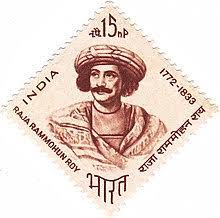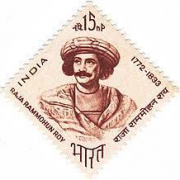MONTHLY BLOG 140, A YEAR OF GEORGIAN CELEBRATIONS – 8: Annual Memorial Service at Bristol’s Arnos Vale Cemetery, to celebrate the life of India’s remarkable religious, social & educational reformer, Raja Ram Mohan Roy (1772-1833)
If citing, please kindly acknowledge copyright © Penelope J. Corfield (2022)

| Republic of India postage stamp (1964), where his name has alternative spelling as Mohun Roy. |
Eighteenth-century Britain witnessed a veritable ferment of ideas. Religious reformers and traditionalists within Christianity battled with one another, whilst religious sceptics, known as ‘freethinkers’, argued against all forms of revealed religion. It was a time for rethinking and renewal; and not just in Britain.
India’s age-old Hindu tradition was also witnessing its own upheavals. One of its most remarkable reformers was a Bengali thinker named Raja Ram Mohan Roy (1772-1833).1 He came from a well-established Brahmin family; and was well educated in an array of languages, although the precise details of his schooling remain disputed. He became familiar with Persian and Arabic studies, as well as with classical Sanskrit. Later he learned other languages, including Latin and Greek. Very evidently, he was a gifted linguist.
But Raja Ram Mohan Roy went further. During his formative years, he interacted with spiritual teachers from diverse religious traditions. One was a famous Baptist missionary in India, William Carey (1761-1834). A growing characteristic of Ram Mohan Roy’s own thought was his desire to see into the heart of religion, to find the one true source of godliness. And his companion wish was to purify religious observances, so that external conventions and rituals did not distract worshippers from the chance of a genuine religious experience.
Such an approach was very characteristic of fundamentalist religious reformers. However, Mohan Roy did not break from the Hindu faith to achieve his aims. He remained within its broad-based tradition, and tried to update its customs. Prominent among the targets which he sought to reform were polygamy; child marriage; and the caste system, whereby people were ‘allocated’ to one social position at birth and kept there by rigid custom. Roy was also vehement against the traditional practice of ‘sati’ or ‘suttee’, which required widows to sacrifice their lives on the funeral pyres of their deceased husbands.
These campaigns turned Ram Mohan Roy into not only a powerful religious moderniser but also a significant social and educational reformer. He was a liberal pioneer of women’s rights.2 He wrote prolifically. He founded educational institutions. He co-founded the Kolkata/Calcutta Unitarian Society and also founded the Brahma Samaj (a social reform group within Hinduism). He supported the use of English in Indian education. In some ways, then, he can be regarded as vector for the spread of Western ideas into India, in that he wanted India to shed its outmoded customs and to become ‘modernised’, like its then rulers – the officials in the East India Company, for whom Roy had worked.3
At the same time, however, Ram Mohan Roy was also a great example of the rich eclecticism of the Hindu tradition. He believed in the inner ‘oneness’ of all religion. (This aspect of his thought appealed to many British and American Unitarians, who abjured Trinitarian Christianity to worship the one divine power). And Ram Mohan Roy clearly did not seek a personal redeemer. So for him there was little point in changing churches, when the divine can be worshipped everywhere: ‘God is one. He has no end. He exists in all the living things on the Earth’.
There were well known later debates within India, as to how far Roy was simply a ‘child of the West’. Yet that viewpoint misses the strength of his Hindu spiritualism. Moreover, he was sufficient of an Indian gentleman to accept the honorific title of ‘Raja’ (prince) from the Mughal Emperor Akbar II in 1830. A determined reformer; yes; but not a social revolutionary.
In September 1833, Raja Ram Mohan Roy was visiting Britain, as an imperial envoy from India. Staying at the small village of Stapleton, near Bristol, he fell ill suddenly and died of meningitis. He was initially buried quietly in the grounds of the house where he had died. But a decade later, his remains were re-interred at the new Arnos Vale Cemetery, at Brislington in East Bristol. This venue was not monopolised by any specific faith. It contains both an Anglican and a Nonconformist Mortuary Chapel; and the authorities made no objection to the inclusion of a devout Hindu.
Ram Mohan Roy’s grave, topped by an Indian Mausoleum, was a fitting component of this ecumenical resting place. At this spot, an annual commemoration of his life and teachings is held every September, at or near the date of his death. Dignitaries like the Mayor of Bristol and the Indian High Commissioner are joined by all other Indians and Britons who wish to share in the remembrance service. There is also a fine statue of Mohan Roy on Bristol’s College Green. And at Stapleton, too, there is today a memorial plaque and a pedestrian walk, named in his honour.
He did not, of course, plan to die in Bristol. But for Raja Ram Mohan Roy, the apostle of spiritual oneness, there is a certain aptness in finding a peaceful resting-place among the dead of many faiths and none. For the history of Georgian Britain, too, Mohan Roy’s quest for spiritual enlightenment and social reform was part of the ferment of debates between believers and freethinkers.
Many globe-trotting Britons ventured to India in these years. Some were seeking colonial power and trading profits, while others, like William Carey, were intent on saving souls. Yet the exchange of ideas and peoples was not just one way. Where then are respects rightly paid to the remarkable Indian reformer, who was the ‘parent of the Bengal Renaissance’ and also a citizen of the world? Why, in Bristol’s Arnos Vale Cemetery, every September.
ENDNOTES:
1 See variously H.D. Sharma, Raja Ram Mohan Roy: The Renaissance Man (2002); D.C. Vyas, Biography of Raja Ram Mohan Roy (New Delhi, 2010); P. Kumari, Women, Social Customs and Raja Ram Mohan Roy (Patna, 2013).
2 Mohan Roy himself married three times. His first two wives predeceased him, and his third wife outlived him, without, of course, committing sati after his death.
3 Among a huge literature, see variously: J. Keay, The Honourable Company: A History of the East India Company (1991; 2017); S. Sen, Empire of Free Trade: The East India Company and Making of the Colonial Marketplace (Philadelphia, 1998); M. Chowdhury, Empire and Gunpowder: Military Industrialization and Ascendancy of the East India Company in India, 1757-1856 (New Delhi, 2022).
For further discussion, see Twitter
To read other discussion-points, please click here
To download Monthly Blog 140 please click here

